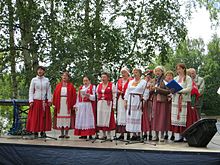Izhorians: Difference between revisions
m formatted some of the references. |
Citation bot (talk | contribs) Alter: doi. Add: s2cid. | Use this bot. Report bugs. | Suggested by Headbomb | #UCB_toolbar |
||
| Line 41: | Line 41: | ||
Their language, close to [[Karelian language|Karelian]], is used primarily by members of the older generation. Izhorian (also called Ingrian), along with [[Finnish language|Finnish]], [[Ludic language|Ludic]], Karelian and [[Veps language|Vepsian]], belongs to the Northern [[Finnic languages|Finnic]] group of the [[Uralic languages]]. |
Their language, close to [[Karelian language|Karelian]], is used primarily by members of the older generation. Izhorian (also called Ingrian), along with [[Finnish language|Finnish]], [[Ludic language|Ludic]], Karelian and [[Veps language|Vepsian]], belongs to the Northern [[Finnic languages|Finnic]] group of the [[Uralic languages]]. |
||
In 1932–1937, a Latin-based orthography for the Izhorian language existed, taught in schools of the [[Soikinsky Peninsula]] and the area around the mouth of the [[Luga River]].<ref name="kurs">{{cite journal |last=Kurs |first=Ott |date=1994 |doi=10.1007 |
In 1932–1937, a Latin-based orthography for the Izhorian language existed, taught in schools of the [[Soikinsky Peninsula]] and the area around the mouth of the [[Luga River]].<ref name="kurs">{{cite journal |last=Kurs |first=Ott |date=1994 |doi=10.1007/BF00810142 |title=Ingria: The broken landbridge between Estonia and Finland |journal=[[GeoJournal]] |volume=33 |number=1 |pages=107–113|s2cid=153619971 }}</ref> Several textbooks were published including a grammar of the language in 1936. However, in 1937 the Izhorian written language was abolished.<ref name="kurs"/> |
||
== Religion == |
== Religion == |
||
Revision as of 01:01, 12 November 2022
 Flag of Izhorians | |
 Izhorian choir wearing the national costume | |
| Total population | |
|---|---|
| 1,143 | |
| Regions with significant populations | |
| 266 (2010)[1] | |
| 812 (2001)[2] | |
| 56 (2011)[3] | |
| 8 (1999)[4] | |
| 1 (2018)[5] | |
| Languages | |
| Izhorian, Russian, Estonian | |
| Religion | |
| Eastern Orthodox Christianity Lutheran minority | |
| Related ethnic groups | |
| Other Baltic Finns | |
The Izhorians (Russian: Ижо́ра; ижо́рцы; Finnish: inkerikot; Estonian: isurid; sg. ižoralain, inkeroin, ižora, ingermans, ingers, ingrian, pl. ižoralaizet), along with the Votes, are a Finnic indigenous people native to Ingria. Small numbers can still be found in the western part of Ingria, between the Narva and Neva rivers in northwestern Russia. Although in English oftentimes sharing a common name with the Finns of Ingria, these two groups are distinct from one another.
History

The history of the Izhorians is bound to the history of Ingria. It is supposed that shortly after 1000 AD the Izhorians moved from Karelia to the west and south-west. In 1478, the Novgorod Republic, where Ingrians had settled, was united with the Grand Duchy of Moscow, and some of the Izhorians were transferred to the east. The establishment of St Petersburg in 1703 had a great influence on Izhorian culture. World War II had the biggest impact on Izhorians, as devastating battles (such as the Siege of Leningrad) took place on their territory.

In 1848, P. von Köppen counted 17,800 Izhorians, and by 1926 there were 26,137 Izhorians in the Russian SFSR. In the 1959 census, however, only 1,100 Izhorians were counted in the USSR. In 1989, 820 self-designated Izhorians, 302 of whom were speakers of the Ingrian language were registered. 449 Izhorians lived in the territory of the USSR. According to the 2002 Russian Census, there were 327 Izhorians in Russia, of whom 177 lived in Leningrad oblast and 53 in St Petersburg. There were also 812 Izhorians in Ukraine according to Ukrainian Census (2001) (more than in Russian Federation and Estonia altogether) and a further 358 Izhorians in Estonia.
Language

Their language, close to Karelian, is used primarily by members of the older generation. Izhorian (also called Ingrian), along with Finnish, Ludic, Karelian and Vepsian, belongs to the Northern Finnic group of the Uralic languages.
In 1932–1937, a Latin-based orthography for the Izhorian language existed, taught in schools of the Soikinsky Peninsula and the area around the mouth of the Luga River.[6] Several textbooks were published including a grammar of the language in 1936. However, in 1937 the Izhorian written language was abolished.[6]
Religion
The Izhorians and the Votes are generally Eastern Orthodox, while the other Baltic Finns inhabitanting Ingria, the Ingrian Finns, are generally Lutheran. Some pre-Christian traditions exist also.
References
- ^ "Russian Census of 2002". Archived from the original on 2011-07-19.
- ^ "Ukrainian Census of 2001".[permanent dead link]
- ^ "RL0428: Rahvastik rahvuse, soo ja elukoha järgi, 31. detsember 2011".
- ^ "Nationalities of Belarus". Archived from the original on 2009-08-15.
- ^ Population distribution of Latvia by ethnic composition and citizenship as of 01.07.2018. - Office of Citizenship and Migration Affairs
- ^ a b Kurs, Ott (1994). "Ingria: The broken landbridge between Estonia and Finland". GeoJournal. 33 (1): 107–113. doi:10.1007/BF00810142. S2CID 153619971.
External links
- Izhorians in the Red Book of the Peoples of the Russian Empire
- Estonian National Museum (in Estonian)
- V. Cherniavskij, "Izoran keel (Ittseopastaja)/Ижорский язык (Самоучитель) (Ingrian Self-Taught Book)" (in Russian)
- Virtual ingrian
